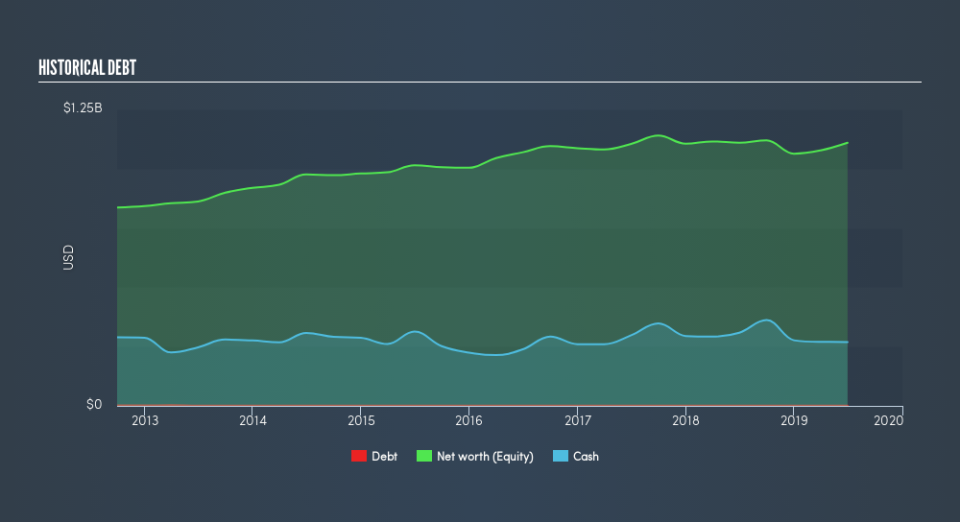Is Robert Half International (NYSE:RHI) Using Too Much Debt?

David Iben put it well when he said, 'Volatility is not a risk we care about. What we care about is avoiding the permanent loss of capital.' So it seems the smart money knows that debt - which is usually involved in bankruptcies - is a very important factor, when you assess how risky a company is. We note that Robert Half International Inc. (NYSE:RHI) does have debt on its balance sheet. But should shareholders be worried about its use of debt?
Why Does Debt Bring Risk?
Debt and other liabilities become risky for a business when it cannot easily fulfill those obligations, either with free cash flow or by raising capital at an attractive price. If things get really bad, the lenders can take control of the business. However, a more usual (but still expensive) situation is where a company must dilute shareholders at a cheap share price simply to get debt under control. Having said that, the most common situation is where a company manages its debt reasonably well - and to its own advantage. The first step when considering a company's debt levels is to consider its cash and debt together.
See our latest analysis for Robert Half International
How Much Debt Does Robert Half International Carry?
As you can see below, Robert Half International had US$559.0k of debt at June 2019, down from US$750.0k a year prior. But on the other hand it also has US$269.4m in cash, leading to a US$268.9m net cash position.
How Strong Is Robert Half International's Balance Sheet?
Zooming in on the latest balance sheet data, we can see that Robert Half International had liabilities of US$909.5m due within 12 months and liabilities of US$220.7m due beyond that. Offsetting this, it had US$269.4m in cash and US$842.3m in receivables that were due within 12 months. So its total liabilities are just about perfectly matched by its shorter-term, liquid assets.
Having regard to Robert Half International's size, it seems that its liquid assets are well balanced with its total liabilities. So while it's hard to imagine that the US$6.18b company is struggling for cash, we still think it's worth monitoring its balance sheet. Despite its noteworthy liabilities, Robert Half International boasts net cash, so it's fair to say it does not have a heavy debt load!
And we also note warmly that Robert Half International grew its EBIT by 12% last year, making its debt load easier to handle. When analysing debt levels, the balance sheet is the obvious place to start. But ultimately the future profitability of the business will decide if Robert Half International can strengthen its balance sheet over time. So if you want to see what the professionals think, you might find this free report on analyst profit forecasts to be interesting.
But our final consideration is also important, because a company cannot pay debt with paper profits; it needs cold hard cash. Robert Half International may have net cash on the balance sheet, but it is still interesting to look at how well the business converts its earnings before interest and tax (EBIT) to free cash flow, because that will influence both its need for, and its capacity to manage debt. Over the last three years, Robert Half International recorded free cash flow worth a fulsome 81% of its EBIT, which is stronger than we'd usually expect. That positions it well to pay down debt if desirable to do so.
Summing up
We could understand if investors are concerned about Robert Half International's liabilities, but we can be reassured by the fact it has has net cash of US$269m. And it impressed us with free cash flow of US$502m, being 81% of its EBIT. So we don't think Robert Half International's use of debt is risky. Another factor that would give us confidence in Robert Half International would be if insiders have been buying shares: if you're conscious of that signal too, you can find out instantly by clicking this link.
If, after all that, you're more interested in a fast growing company with a rock-solid balance sheet, then check out our list of net cash growth stocks without delay.
We aim to bring you long-term focused research analysis driven by fundamental data. Note that our analysis may not factor in the latest price-sensitive company announcements or qualitative material.
If you spot an error that warrants correction, please contact the editor at editorial-team@simplywallst.com. This article by Simply Wall St is general in nature. It does not constitute a recommendation to buy or sell any stock, and does not take account of your objectives, or your financial situation. Simply Wall St has no position in the stocks mentioned. Thank you for reading.

 Yahoo Finance
Yahoo Finance 
